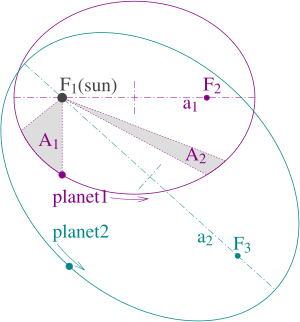Kepler's Laws facts for kids

Kepler's laws of planetary motion are three important rules that explain how planets move around the Sun. A scientist named Johannes Kepler discovered these laws between 1609 and 1619. They helped us understand the Solar System much better.
Here are Kepler's three laws:
- First Law (Law of Ellipses): Planets do not orbit the Sun in perfect circles. Instead, they move in paths shaped like ellipses. An ellipse looks like a stretched circle. The Sun is not exactly in the center of this ellipse, but at one of its special points called a focus.
- Second Law (Law of Equal Areas): Imagine a line connecting a planet to the Sun. As the planet moves, this line sweeps out an area in space. Kepler's second law says that this line always sweeps out the same amount of area in the same amount of time. This means a planet moves faster when it is closer to the Sun and slower when it is farther away.
- Third Law (Law of Harmonies): This law compares the orbits of different planets. It says that the time a planet takes to go around the Sun (its orbital period) is related to the size of its orbit. Specifically, if you square the orbital period, it will be proportional to the cube of the average distance of the planet from the Sun. This means planets farther from the Sun take much longer to complete one orbit.
Most planetary orbits look almost like circles. It took very careful observations and math to figure out they are actually ellipses. For example, studying the orbit of Mars helped Kepler discover these elliptical paths. He then realized that all other planets in our Solar System also follow elliptical orbits.
Kepler's discoveries greatly improved the heliocentric theory. This theory states that the Sun is at the center of our solar system, not Earth. Before Kepler, people thought planets moved in perfect circles, sometimes with smaller circles called epicycles. Kepler showed that ellipses explained planetary motion much better and also explained why planets change speed.
Later, in 1687, Isaac Newton showed why Kepler's laws work. Newton's own laws of motion and his law of universal gravitation explained the forces that cause planets to move in these elliptical paths.
Images for kids
See also
 In Spanish: Leyes de Kepler para niños
In Spanish: Leyes de Kepler para niños


